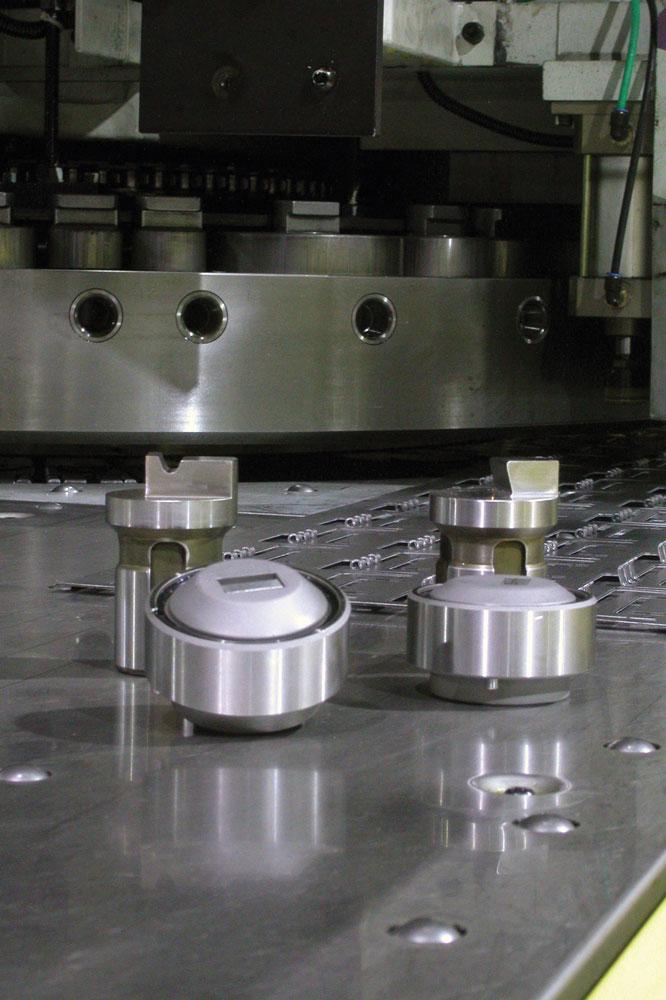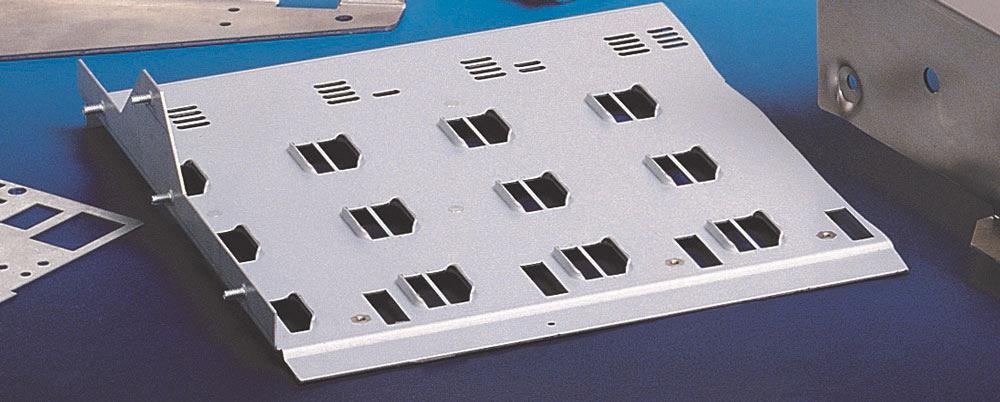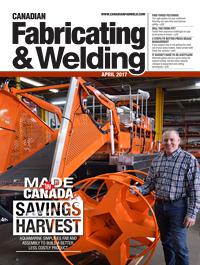- FMA
- The Fabricator
- FABTECH
- Canadian Metalworking
Forming profits on a turret
More complex forms from servo-electric machines, fewer downstream processes
- By Canadian Fabricating & Welding
- May 12, 2017
- Article
- Fabricating

Servo-electric technology paired with specialty tooling is making it efficient and economical to produce complex forms on a turret. Photo courtesy of Murata Machinery USA Inc.
Servo-electric punch drive systems on turret presses are working with fabricators to speed cycle times, reduce energy expenditures, increase accuracy, and lower maintenance costs. But that’s not all.
When paired with innovative tooling, according to Rick Dorman, fabrication sales manager—North America for Murata Machinery USA, those savings also make using the turret to add forms to a sheet more and more attractive. He cautions that forming on a turret can be a bit of a science and there is a learning curve, but elimination of downstream processes, gained accuracies, new abilities from tooling options, and the advantage of the servo-electric speed can make it a very worthwhile exercise.
Dorman answered some questions on what is needed, from the OEM perspective, to make forming on a turret a profitable process.
CFW: Why does servo-electric technology make it easier to form on a turret?
Dorman: Forming is more reliable with servo-drive technology because it is mechanically controlled. You can set the depth of the stroke, which gives you the height of the form, and it remains consistent. With hydraulics, that height could change somewhat over the course of the day depending on the shop environment and hydraulic temperatures
CFW: In addition to servo-electric technology, what is the key turret feature needed to allow it to form successfully?
Dorman: Major factors you must consider when forming on the turret are the turret gap, or clearance between the upper and lower turrets, and the form height. The turret gap, usually measuring around 0.984 in. (25 mm), generally allows a form height of 0.531 in. (13.5 mm) using a standard forming assembly. However, depending on the application, you could possibly utilize some of the new tooling designs and achieve a taller form height.
In a forming operation, the lower die is thicker than a standard die because it has a lot of spring action to strip it off the form. So in a standard turret, the forming die will stick up into the gap, and the material could ride along on top of the die. If you punch using a station adjacent to the forming tooling, there can be some sheet deformation because the punching force can bend the sheet over the higher forming tool or you can get some marking.
To help eliminate this problem, some manufacturers offer retractable forming that keeps the punching and forming dies all at the same height. The forming dies are kept at punching die height until the process is ready for the forming operation. Then the lower die assembly is raised up into working position, the form is made, then it retracts out of the way. The servo drive pushes the die up into place and the punch stroke is normal.
Upforming is another way to handle turret forming. Punch and forming tooling is at the same height, but pressure is put on the top and the bottom of the sheet to make the forms. The turret is forming up from the bottom and down from the top.
CFW: What about downforming?
Dorman: The downforming process limits the height of a form that can be made simply because if the form is too deep, it can get hung up on the equipment when the sheet is moved. A downform is usually kept to around 2 or 3 mm. A smooth, embossed downform might glide over the equipment without being damaged. A form with an abrupt edge, for example a large screw extrusion, may have to be moved along a certain machine axis to avoid bouncing all over the table and potentially being damaged. In these cases, a brush table is recommended.
Generally, if a company anticipates downforming on the turret, it adds a downform protection option. With this option, a machine will create the downform, then lift the sheet up while it is moved to eliminate the possibility of the form getting caught on anything.
CFW: Does the sequence of the punching and forming operations make a difference?
Dorman: Absolutely. The program needs to sequence properly. For example, if a hole needs to be punched next to a form, the hole should be made first. If the form is made first, the punch assembly can smash into the form while trying to do its job.
If a form is right along the edge of a sheet or at the bottom of a part edge, you may have to use the parting tool for a couple of hits first, put the form in, and then do the rest of the part. Again, that’s because you can’t put a form in and have another tool, even the parting tool, hit close to the form without causing damage.
A lot of software properly handles this type of sequencing, but it still needs to be watched.
CFW: How does automation come into play?
Dorman: Whether its automated part sorting or sheet unloading, if forms are involved, it makes a difference. If you stack components that have forms in them on a pallet, they build up faster and have the potential to start leaning. So you have to be careful of stack heights when you are unloading. You can do it … you just have to be careful. That gets into some programming when you tell the automation where—and how high—to stack the parts.
CFW: What are some new capabilities of a turret punch press that is coupled with specialty tooling?

Sequencing of programs involving formed parts is critical to avoid damage to a form as other features are processed. Photo courtesy of Murata Machinery USA Inc.
Dorman: A nice thing about servo-electric processes is that you can do more with special tooling. In addition to things like extrusions and countersinks, you can incorporate special tooling for deburring or tapping holes. These can all be accomplished in the turret by controlling the ram setting.
There are also tools that assist with assembly. They act like joints in a tool so that when you form them up, they lock in place. One side has a tab with a hole in it, and the other side has a shear button so they lock in place. For example, fixturing to weld a corner or spot weld a part can be eliminated if a punch press and its tooling can quickly produce interlocking forms that move on to welding. You can get a lot of self-fixturing going on, and the accuracy of the part is based on the accuracy of the turret.
Everyone is trying to do as much as possible using turrets to eliminate secondary operations. Being able to form a flange or an offset ridge in a turret reduces handling time and can eliminate secondary operations.
Murata Machinery USA Inc. 866-431-1931, www.muratec-usa.com/punchpress
About the Author
Canadian Fabricating & Welding
subscribe now


Keep up to date with the latest news, events, and technology for all things metal from our pair of monthly magazines written specifically for Canadian manufacturers!
Start Your Free Subscription- Trending Articles
Aluminum MIG welding wire upgraded with a proprietary and patented surface treatment technology

CWB Group launches full-cycle assessment and training program

Achieving success with mechanized plasma cutting

Hypertherm Associates partners with Rapyuta Robotics

Brushless copper tubing cutter adjusts to ODs up to 2-1/8 in.

- Industry Events
MME Winnipeg
- April 30, 2024
- Winnipeg, ON Canada
CTMA Economic Uncertainty: Helping You Navigate Windsor Seminar
- April 30, 2024
- Windsor, ON Canada
CTMA Economic Uncertainty: Helping You Navigate Kitchener Seminar
- May 2, 2024
- Kitchener, ON Canada
Automate 2024
- May 6 - 9, 2024
- Chicago, IL
ANCA Open House
- May 7 - 8, 2024
- Wixom, MI
















